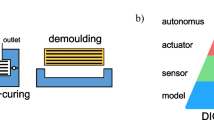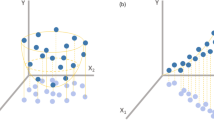Abstract
Designing extrusion dies remains a tricky issue when considering polymers. In fact, polymers exhibit strong non-Newtonian rheology that manifest in noticeable viscoelastic behaviors as well as significant normal stress differences. As a consequence, when they are pushed through a die, an important die-swelling is observed, and consequently the final geometry of the extruded profile differs significantly from the one of the die. This behavior turns the die’s design into a difficult task, and its geometry must be defined in such a way that the extruded profile results in the targeted one. Numerical simulation was identified as a natural way for building and solving the inverse problem of defining the die, leading to the targeted extruded geometry. However, state-of-the-art rheological models reveal inaccuracies for the desired level of precision. In this paper, we propose a data-driven approach that, based on the accumulated experience on the extruded profiles for different dies, learns the relation enabling efficient die design.












Similar content being viewed by others
References
Sharma S, Goswami M, Deb A, Padhan B, Chattopadhyay S (2021) Structural deformation/instability of the co-extrudate rubber profiles due to die swell: experimental and cfd studies with 3d models. Chem Eng J 424:130504
Sharma S, Sarkar K, Goswami M, Deb A, Dcunha S, Chattopadhyay S (2020) An approach to design extrusion dies for complex shaped rubber profiles using finite element analysis. J Manuf Process 57:700–711
del Coz Diaza J, Nieto PG, Mere JO, Garcia AB (2007) Computer simulation of the laminar nozzle flow of a non-newtonian fluid in a rubber extrusion process by the finite volume method and experimental comparison. J Non-Cryst Solids 353(8–10):981–983
del Coz Diaza J, Nieto PG, Garcia AB, Munozc JG, Mere JO (2008) Finite volume modeling of the non-isothermal flow of a non-newtonian fluid in a rubber’s extrusion die. J Non-Cryst Solids 354(47–51):5334–5336
Wagner A, Yazici R, Kalyon DM (19963) Extrudate swell behavior of glass fiber filled polyamide 6. Polym Compos 17(6):840–849
Tang D, Marchesini FH, Cardon L, D’hooge DR (2020) State of the-art for extrudate swell of molten polymers: From fundamental understanding at molecular scale toward optimal die design at final product scale. Macromol Mater Eng 305(8–10):2000340
Ghnatios C, Hage R-M, Hage I (2019) An efficient tabu-search optimized regression for data-driven modeling. Compte Rendu Mecanique 347(11):806–816
Reille A, Hascoet N, Ghnatios C, Ammar A, Cueto E, Duval JL, Chinesta F, Keunings R (2019) Incremental dynamic mode decomposition: a reduced-model learner operating at the low-data limit. Comptes Rendus Mecanique 347:780–792
Ibanez R, Casteran F, Argerich C, Hascoet CGN, Ammar A, Cassagnau P, Chinesta F (2020) On the data-driven modeling of reactive extrusion. MDPI Fluids 5(2):94
Liu X, Tian S, Tao F, Yu W (2021) A review of artificial neural networks in the constitutive modeling of composite materials. Compos Part B Eng 224:109152
Ghnatios C, Alfaro I, Gonzalez D, Chinesta F, Cueto E (2019) Data-driven generic modeling of poroviscoelastic materials. Entropy 21(12):1165
González D, Chinesta F, Cueto E (2019) Thermodynamically consistent data-driven computational mechanics. Contin Mech Thermodyn 31:239–253
Ghnatios C (2021) A hybrid modeling combining the proper generalized decomposition approach to data-driven model learners, with application to nonlinear biphasic materials. Comptes Rendus Mecanique 349(2):259–273
Ghnatios C, Barasinski A (2021) A nonparametric probabilistic method to enhance pgd solutions with data-driven approach, application to the automated tape placement process, Advanced modeling and simulation in engineering sciences 8(20). https://doi.org/10.1186/s40323-021-00205-5
Ghnatios C, Montes N, Tertrais H, Duval J, Abisset-Chavanne E, Falco A, Chinesta F (2019) Towards parametric rtm processes: the interpolative mapping. Am Inst Phys Proc. doi 10(1063/1):5112637
Ghnatios C, Azzi M-J, Tezaur R, Avery P, Farhat C (2021) Acceleration of a nonparametric probabilistic method for model updating to enable digital twin instance applications. In: The 4th international conference and exhibition on additive manufacturing technologies, vol 1
Chen W, Wang W, Liu L, Lew MS (2021) New ideas and trends in deep multimodal content understanding: a review. Neurocomputing 426:195–215
Jolliffe IT, Cadima J (2016) Principal component analysis: a review and recent developments. Phylosophical Trans R Soc A: Math Phys Eng Sci 374(2065):1–16
Hea X, Heb Q, Chen J-S (2021) Deep autoencoders for physics-constrained data-driven nonlinear materials modeling. Comput Methods Appl Mech Eng 285:114034
Kramer M (1991) Nonlinear principal component analysis using autoassociative neural networks. AIChE Journal 27(2):233–243
Author information
Authors and Affiliations
Corresponding author
Ethics declarations
Conflicts of interest
The authors declare that they have no conflict of interest.
Additional information
Publisher's Note
Springer Nature remains neutral with regard to jurisdictional claims in published maps and institutional affiliations.
Rights and permissions
Springer Nature or its licensor (e.g. a society or other partner) holds exclusive rights to this article under a publishing agreement with the author(s) or other rightsholder(s); author self-archiving of the accepted manuscript version of this article is solely governed by the terms of such publishing agreement and applicable law.
About this article
Cite this article
Ghnatios, C., Gravot, E., Champaney, V. et al. Polymer extrusion die design using a data-driven autoencoders technique. Int J Mater Form 17, 4 (2024). https://doi.org/10.1007/s12289-023-01796-7
Received:
Accepted:
Published:
DOI: https://doi.org/10.1007/s12289-023-01796-7




